Writer: Karla Walsh
Many people think of hot dogs and hamburgers as the most “all-American” foods, but pizza is a dish we dig even more. The average American consumes 156 slices per year, and 1 in 3 of us snacks on at least one slice per week, according to a recent survey from Gozney, which makes outdoor ovens.
Just a decade or two ago, most of those slices came from the likes of Domino’s or DiGiorno. Here in Des Moines, with its deep Italian- American roots, many pizzas have also come from a robust array of locally owned pizza parlors.
But the pandemic ushered in more than a homemade bread boom. It also marked a spike in DIY pizzas. So these days, it’s not uncommon to see wood-fired pizza ovens on back patios and outdoor kitchens. Zillow estimates that this one feature can add 4% to a home’s value.
CJ Bienert, owner of The Cheese Shop and Cheese Bar, was one of the early adopters. “My pandemic nesting project was to put in a wood-fire pizza oven,” he said. Ever since, he and his family have gotten a kick out of experimenting with pizza sauces, toppings and, of course, cheeses.
DIY pies are nothing new to George Formaro, the chef-partner with Orchestrate Hospitality restaurants, including Centro, Django, Gateway Market and South Union Bakery, who has tended to and crafted countless crusts with the same sourdough starter since 1989. (This is what Gateway uses for its balls of refrigerated pizza dough.) But Formaro’s passion for pizza goes even further; this spring, he went to Italy to “research” 12-course pizza tasting menus in Caiazzo, Italy.
Jacob Schroeder, chef-owner of Crafted Food Services and co-owner of Moxie Kitchen + Events, also knows his way around a hand-crafted pizza. He hosts two popular culinary events in town: “Pizza Picnics” at Plant Life Designs, featuring seasonal wood-fired pies, and “Big Cheese” at Moxie, where his Detroit-style crusts steal the show.
To help you construct and cook your own homemade pizzas like the pros, in an indoor or outdoor oven, we asked these three culinary experts to dish.
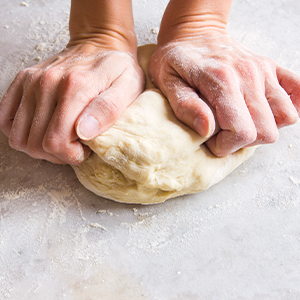 Dough
Dough
Dough can be daunting, so it’s best to start with a simple dough that can be pushed out onto a greased pan, without any fancy spins or tosses or a rolling pin.
In general, hotter ovens require more water in the dough. You can find many sourdough and yeast-risen dough recipes online, but be sure to check the water-to-flour ratio and the recommended cooking temp before you dive in. “Hydration will have the biggest effect on the overall eating experience,” Schroeder said.
For wood-fired pizzas, in particular, “bake this style of pie most of the way without the cheese, gauging the doneness of the bottom of the crust,” Formaro said. “Then put the cheese on for the last few minutes to get it done however much you like while ensuring the crust is nice and crispy.”
Take it easy: Buy a dough ball from the refrigerator case near the produce section at Gateway Market, or call your favorite pizza shop and ask if you can purchase a ball of dough, or several.
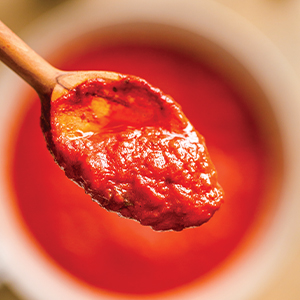 Sauce
Sauce
Both Formaro and Schroeder are fond of simmering their own pot of sauce, but they both give a big thumbs-up to jarred marinara. It’s possible to make the store-bought stuff taste like you toiled over the stove all day if you doctor it up a bit.
Is it bland? Sprinkle in some Italian seasoning, add a spoonful of chili crisp or white miso, stir in a few minced garlic cloves, or toss in a few freshly torn basil leaves.
Could it use some richness? Add a glug of extra virgin olive oil or a handful of freshly grated Parmesan or Romano cheese.
Does it seem watery? Mix in a squeeze of high-quality tomato paste from a tube.
But don’t feel limited to red sauce. Mix things up by using your favorite jarred Alfredo, herb-infused oil or butter, fruit chutney, fruit butter (like apple or fig), non-creamy salad dressing, or pureed roasted vegetables like corn or squash.
Take it easy: You can find Schroeder’s classic marinara recipe online, but here’s his easiest-ever version. To a blender pitcher, add one 28-ounce can of whole peeled plum tomatoes and a 1/2 teaspoon salt. Pulse to puree, then ladle it on top of your stretched dough.
Pie math
It can be tricky to dial in exactly how much of each element you’ll need per pie. Here’s Schroeder’s ratio for a 10-inch pizza:
• 7 to 8 ounces of dough
• 1 1/2 ounces of sauce
• 1/4 pound of cheese (1 cup shredded)
• 1/2 cup total of toppings
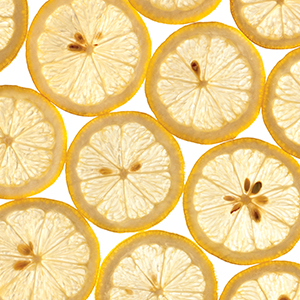 Toppings
Toppings
“The sky’s the limit when it comes to pizza toppings,” Formaro said. “Anything that can be served on a dish can be made into a pizza.”
The most important factors for top-notch toppings? It’s moisture control and flavor, Schroeder said. To tackle both at once, he recommends cooking the toppings (that you don’t plan to add fresh as a garnish) before adding them to the pizza. “Usually people throw raw ingredients on it, which is fine, but you can’t control the seasoning this way. Pre-cooking all of the ingredients also helps you control the moisture while adding flavors you wouldn’t be able to achieve,” he said. “For example, toss cauliflower and broccoli florets in olive oil, then place them on a sheet pan and roast them really hard. Charring makes all the difference.”
Try not to overthink your toppings, and don’t use a mountain of them. “Use a light hand when it comes to toppings,” Schroeder said. “You still want to be able to see through all of the toppings to spot some of the sauce.” This will create a balance of flavor and prevent your slices from flopping over.
We’ve included some creative global and seasonal toppings in our chart to the right, but why stop there? Here are a few often-overlooked toppings that Formaro and Schroeder recommend:
• Thinly sliced lemons or lemon zest
• Truffle paste or truffle oil
• Anchovies
• Clams
• Fried calamari rings
• Slices of rare tuna
• Leftover sliced or shredded braised meat
• Thin slices of Mortadella
• Grilled vegetables
• Arugula or microgreens
• Toasted nuts and seeds
• Crushed crackers, toasted breadcrumbs or crumbled potato chips
Take it easy: Start with a classic: red sauce, cooked and crumbled Graziano’s sausage, sauteed mushrooms and freshly grated Pecorino-Romano cheese. Then once you’ve gotten comfortable with your tools and dough, mix things up by using our handy chart, below.
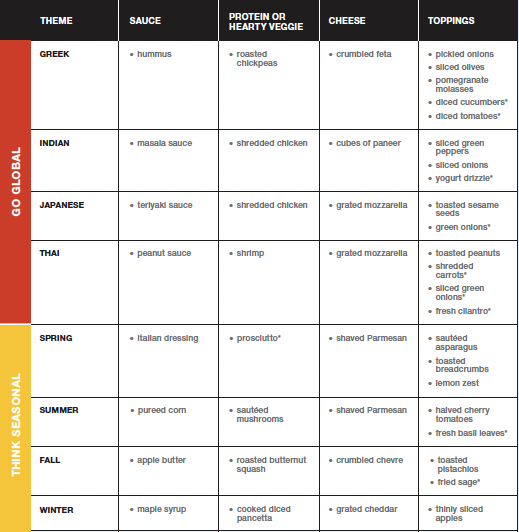
* Add these ingredients right before serving
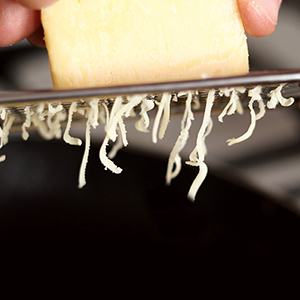 Cheese
Cheese
Aged cheeses might be prized for your appetizer charcuterie boards, but pizza is not the place for them. “Aged cheeses don’t tend to melt well,” Bienert said. “As a cheese ages, its protein matrix will break down, so it’s basically useless. They will ‘oil off’ and turn into greasy clumps on top of your pizza.”
For pizzas, look for “squishy” cheeses, Bienert said. “Semisoft cheeses all melt really well.”
Once again, the oven temperature matters. With higher heat, opt for higher-moisture cheeses, such as buffalo mozzarella and burrata. The extra moisture will prevent your pizza from getting too brown during its quick hot shift in the oven. For indoor cooking in a kitchen oven that often tops out at 550 degrees, seek out low-moisture mozzarella.
No matter which cheese you choose, buy it in blocks rather than shreds, Bienert said. “Pre-shredded cheeses have cellulose and starch that’s meant to prevent the cheese pieces from sticking together.”
As you shop for ingredients, keep in mind that 1/4 pound of cheese grates down to about 1 cup, which is ideal for a single-serving pie. Bienert recommends any of The Cheese Shop options listed at right, but there’s no need to stick to just one. Feel free to blend two or more. This works particularly well if you use a mild cheese for the majority, then add a bit of a bolder option, like blue or goat cheese.
Substitute stracciatella
Burrata cheese is essentially a thin layer of mozzarella holding a filling of stracciatella, a mixture of cream and mozzarella shreds. When he can’t find burrata at the store, Formaro makes a “fake” version at home in a food processor by pulsing a ball of fresh mozzarella with 2 tablespoons of heavy cream and a pinch of salt and black pepper.
Take it easy: Stop by The Cheese Shop and ask the cheesemongers to recommend a cheese that works well with your oven and the toppings you have in mind.
The Cheese Shop recommends
“A young gouda from Iowa-based Frisian Farms is our go-to,” Bienert said, referring to his family’s wood-fired pies.
The Bienert kids also adore raclette, which pairs well with sausages and cured meats like La Quercia prosciutto and onions.
“We sell a lot of Wisconsin brick cheese, which has been popular for folks making Detroit-style pizza. It browns so well,” he said. “Those crispy bits of cheese around the edge are incredible.”
For white sauce pies, consider rich and nutty Ossau-Iraty sheep’s milk cheese from France.
The hand-stretched mozzarella they make in-house at The Cheese Shop works well for classic Neapolitan-style Margherita pizzas.
Tools and Techniques
BW Outdoors in Valley Junction sells portable pizza ovens. Kitchen Collage in the East Village has several culinary tools that will help you channel your inner pizzaiolo. Here are the tools that Schroeder and Formaro use most often:
• Detroit-style pizza pans
• A heat-resistant, variable speed immersion blender
• An infrared thermometer (to measure your oven’s temperature)
• A pizza peel
• A heat-safe large spatula or pizza turner
• A pizza screen (to achieve a springy crust indoors)
• A pizza steel (for indoor cooking)
“The biggest upgrade for cooking pizza at home is getting a pizza steel,” Schroeder said. “This recreates a commercial kitchen deck. It’s a 1/2-inch slab of stainless steel that can hold onto energy, so it puts more heat into the crust itself.”
To get good results inside, preheat the pizza steel and oven for 1 hour to 450 to 550 degrees, depending on your recipe. Put the pizza on a dark, heavy baking pan, then place that on top of the pizza steel, and bake it until the crust is browned and the cheese is bubbly.
Another way to replicate a wood-fired oven is on your regular charcoal or gas grill. Place the crust on the grill to char one side to “get that characteristic char and leoparding spots,” Formaro said. Then move the crusts inside, add your sauces, toppings and cheese, then bake it in the oven. “You can prep the crusts ahead this way and speed up your pizza party service times drastically. Do a bunch of crusts at once, then take them inside,” he said.
Love your leftovers
If you’re lucky enough to have extra slices, “the air fryer or toaster oven works great,” Formaro said. Or heat a slice or two in the microwave for 20 seconds, then crisp up the bottom crust in a dry cast-iron pan over medium heat for about 5 minutes.
Detroit-Style Pizza Dough
Yield: One 10-inch round pan pizza or one 8-by-10-by-2-inch Detroit-style pizza
Ingredients
- 1 ½ cups plus 1 tablespoon (370 grams) water
- 1 teaspoon (3.2 grams) dry active yeast
- 4 cups (500 grams) all purpose or “00” flour (such as Caputo brand)
- 1 tablespoon plus 1 teaspoon (9.4 grams) salt
- 2 cups (8 ounces) low-moisture mozzarella cheese
- ½ cup (130 grams) marinara sauce
- Nonstick cooking spray
Directions
- To the bowl of a stand mixer fitted with a dough hook, add the water, yeast, flour and salt. Mix on low for 12 to 15 minutes. When the dough starts to form a ball at the top of the hook, it’s ready.
- Spray your work surface and the dough proofing vessel with nonstick cooking spray, then coat your hands in nonstick cooking spray or oil. (The dough is very sticky.) Take the dough out of the bowl and place it on the work surface. Cut the dough into two equal portions (440 grams) and form each into a ball.
- Place the dough balls in their proofing vessels and spray the top with nonstick cooking spray. Cover tightly with plastic wrap, with the plastic pressed directly on top of the dough.
- Transfer the dough to the fridge to proof overnight.
- The next day, preheat your oven to 475 degrees and coat a 10-inch cast-iron skillet or an 8-by-10-inch Detroit-style pizza pan with nonstick cooking spray. Put your dough ball in the pan, and stretch it to cover the bottom. (Small gaps of less than ½ inch in the corners are OK.)
- Top the dough with 8 ounces (or 2 cups) of low-moisture mozzarella cheese. Bake for 11 to 14 minutes, or until the cheese on the edge of the pan has browned nicely.
- Remove the pizza from the oven, top with ½ cup marinara, then return to the oven for a few minutes, just until the sauce is heated through.
- Remove the pan from the oven and set on a heat-safe surface. Use a butter knife or offset spatula to loosen the cheese crust from the pan, then work the butter knife or offset spatula underneath the pizza to lift it from the pan and onto a cutting board. Slice and serve.
Homemade Marinara
Yield: About 7 cups
Ingredients
- Olive oil
- 3 medium (93 grams) shallots, sliced
- ¼ cup (40 grams) crushed garlic cloves
- 1 6-ounce can tomato paste
- 2 tablespoons (4 grams) dried basil
- 2 tablespoons (4 grams) dried oregano
- ½ tablespoon (4 grams) freshly ground black pepper
- 1 tablespoon (8 grams) salt
- 2 teaspoons (4 grams) fennel, toasted and ground
- ½ cup (125 grams) dry red wine
- 2 28-ounce cans whole peeled plum tomatoes
Directions
- Coat the bottom of a large saucepan in olive oil, then place it over medium-high heat.
- Once it’s shimmering, or after about 2 minutes, add the shallots and garlic. Saute them just until soft, then add the tomato paste. Turn the heat up to high and cook, stirring frequently, until the paste begins to brown.
- Add the basil, oregano, black pepper, salt, fennel and red wine. Allow the wine to reduce by half, then stir in the tomatoes. Bring the sauce to a boil, then remove it from the heat.
- Use an immersion blender to pulse the tomatoes and to create your desired consistency.












